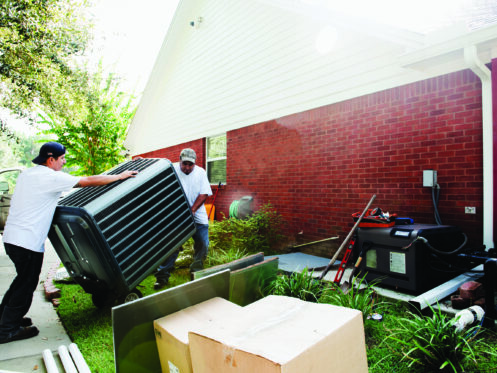When it’s time to get a new HVAC system installed in your home, it can be exciting. However, if this is your first HVAC installation, it can also be a bit overwhelming. Fortunately, we’re going to go over the basic installation process so that you know what to expect come your scheduled installation day.
Pre-Installation Site Inspection
After your initial consultation for a HVAC system installation, it’s likely that you’ll also have a follow-up consultation. This will be more of a site inspection to allow the HVAC provider to determine the specifics of your particular installation job.
This could include determining the special tools they need; any obstructions that may be in the way; the best route for removing your old HVAC unit; and so forth. A pre-installation inspection is a great way to ensure that your installer will have minimal problems during the actual installation process.
Understand Common Timeframes
It’s important to realize that the timeframe for installing a new HVAC system is going to vary depending on a number of different factors. These include things like the type of system installed; the size of your home; ductless or ductwork; and the installation company. Your HVAC installer should be able to provide you with an estimated timeframe for the installation. Most residential installations with existing infrastructure will take one to two days.
Have a Plan
If you’re like most homeowners, you may have small children and/or animals running around. It’s very important that you make a plan for where your kids and animals will be during the installation process. You want to keep them away from the work of the HVAC company technicians for their own safety and the safety of the workers on-site.
Clear Out Your Space
Another necessary part of prepping for installation day is clearing out any items that may be within the space that your technicians will be working in. You want to move away any valuable items that could get in the way. Any clutter that makes it hard to maneuver in the area should be removed as well. Ensure that there is a clear pathway for where your technician plans on removing your old HVAC system out to their vehicle. This will help to speed up the process when installation day comes around.
Safely Removing Refrigerant
Once your installation team arrives, their first order of business will be removing your old HVAC system. This will clear space for the new system to be installed. However, before the old system can be physically removed, the refrigerant inside it needs to be safely recovered.
Refrigerant is a substance that is used to transport heat from one location to another. It’s used in heat pumps and home air conditioning systems. Refrigerants can be dangerous to both people and the environment if not safely handled. Your installation team will have an EPA-certified technician that will be responsible for using a recovery machine to capture the remaining refrigerant inside your old HVAC system.
Removing the Old System
Once all the refrigerant is pumped out, your technicians will move on to removing the old system wiring. They’ll need access to your electrical panel box so they can shut off the circuit breaker to your unit. Once all the old wiring is disconnected, your old unit will be transported out of your home. Typically, your HVAC provider will take care of disposing of the old unit.
Prepping for the New Unit
Next, your HVAC technicians will prep the area for your new HVAC unit. This process is going to look a little bit different for each installation. For example, if your old unit didn’t have a disconnect box installed, your technician will likely install a new box. This will not only provide more safety for your family, but it’s typically a necessity to meet the new system manufacturer’s installation specifications. All of these installation specifications must be met for the new system warranty to be activated.
In another case, the pad that your old AC unit sat on may have sunken, creating an unlevel surface. This will need to be removed and leveled back out before the installation process can proceed. Your technicians should be able to explain any of these unique prepping steps that they’ll have to do prior to your installation day so that you can be adequately prepared.
Old Copper Lines
If you’re having a replacement heat pump or air conditioning unit installed, then you have existing copper lines. These run from the interior of your home to the outdoor unit. These lines are responsible for transporting refrigerant and will likely need to be updated with your new system. This is because lines that used old refrigerants can’t be hooked up to new systems that rely on a different type of refrigerant.
These copper lines may run beneath your floor, under the ground, through concrete, or even in your ceiling. Your installation technicians may need to rip up these lines. If it’s impossible to do so, they may utilize special equipment to flush the old set of lines. This is a specialized cleaning procedure that removes all the old refrigerant residue.
New System Installation
Finally, the one step that every homeowner is excited about is when the new HVAC system is installed. After setting the unit and its components in place, your technicians will go about connecting the unit. They’ll connect the electrical power, drain line, copper lines, and so forth. Once the entire unit is installed properly, they’ll recharge the refrigerant. This process is all about pressurizing the copper lines and injecting the refrigerant into your AC or heat pump system.
Test Run
Once the entire system has been installed and the circuit breaker has been turned back on, your HVAC technicians will do a test run. They will make sure that your system is cooling or heating appropriately. You may hear these referred to as cooling or heating loads. They’ll also ensure that your existing thermostat or your new thermostat is working correctly.
Finalizing the Install and Follow-Up Inspection
Once your HVAC technician is happy with their test runs, they will proceed to clean up all of their equipment. They should supply you with warranty information regarding your new system. Put these documents in a safe place, as you’ll likely need them later on down the road if you run into an issue.
You can expect your technician to schedule a follow-up appointment a couple of days after the initial installation is complete. This follow-up appointment will involve checking your system’s airflow, testing your thermostat, checking for any loose connections or leaks, and so forth.
Expert HVAC Installation Services
First Choice Plumbing, Heating & Air Conditioning provides expert HVAC installation service to Metuchen, NJ and the surrounding areas. We can also help with all of your plumbing, indoor air quality, and commercial needs, as well as all of your HVAC repair and maintenance. Contact First Choice Plumbing, Heating & Air Conditioning today to get on the schedule.




